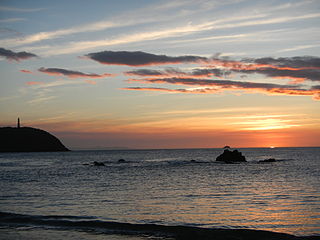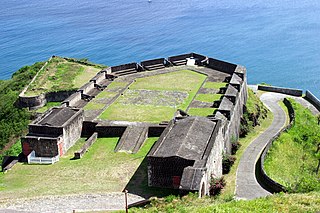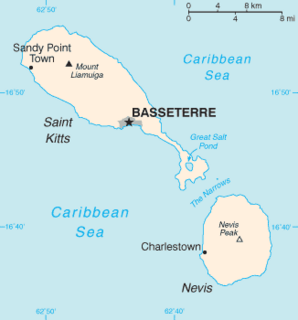Araya, Venezuela | |
|---|---|
| Coordinates: 10°34′N64°15′W / 10.567°N 64.250°W Coordinates: 10°34′N64°15′W / 10.567°N 64.250°W |

Araya is a town located on Venezuela's Caribbean coast, on the westernmost extremity of the Araya Peninsula.
Araya, Venezuela | |
|---|---|
| Coordinates: 10°34′N64°15′W / 10.567°N 64.250°W Coordinates: 10°34′N64°15′W / 10.567°N 64.250°W |

Araya is a town located on Venezuela's Caribbean coast, on the westernmost extremity of the Araya Peninsula.
The Araya Fortress is a beige-brown stone masonry fortification. The fortification was built in order to defend Araya and the Araya Peninsula against Caribbean pirates.
The Spanish Empire only focused on the pearls that could be found off the coast. Because this area had the largest salt plains in the country, [1] the Dutch and the English started extracting the salt, an important product at that time.
When the pearl harvesting came to an end, the Spanish used the fort to defend the salt plains against the English and the Dutch. The fort was abandoned after a hurricane destroyed the area and the salt reserves were lost.


Omoa is a town, with a population of 7,020, and a municipality in the Department of Cortés in Honduras. Omoa is located on a small bay of the same name 18 km west of Puerto Cortés on the Caribbean Sea coast.

The Nueva Sparta State, is one of the 23 states of Venezuela. It comprises Margarita Island, Coche, and the largely uninhabited Cubagua.

Sucre State is one of the 23 states of Venezuela. The state capital is Cumaná city. Sucre State covers a total surface area of 11,800 km2 (4,600 sq mi) and, as of the 2011 census, had a population of 896,921. The most important river in the state is the Manzanares River.

Alonso de Ojeda was a Spanish explorer, governor and conquistador. He travelled through Guyana, Venezuela, Trinidad, Tobago, Curaçao, Aruba and Colombia. He navigated with Amerigo Vespucci who is famous for having named Venezuela, which he explored during his first two expeditions, for having been the first European to visit Guyana, Curaçao, Colombia, and Lake Maracaibo, and later for founding Santa Cruz.

Brimstone Hill Fortress National Park is a UNESCO World Heritage Site, a well-preserved fortress on a hill on the island of St. Kitts in the Federation of St. Christopher and Nevis in the Eastern Caribbean. It was designed by British military engineers, and was built and maintained by enslaved Africans. It is one of the best preserved historical fortifications in the Americas.

Margarita Island is the largest island in the Venezuelan state of Nueva Esparta, situated off the northeastern coast of the country, in the Caribbean Sea. The capital city of Nueva Esparta, La Asunción, is located on the island.

The Guajira Peninsula[gwaˈxiɾa, gwaˈhiɾa] is a peninsula in northern Colombia and northwestern Venezuela in the Caribbean. It is the northernmost peninsula in South America and has an area of 25,000 km2 (9,700 sq mi) extending from the Manaure Bay (Colombia) to the Calabozo Ensenada in the Gulf of Venezuela (Venezuela), and from the Caribbean to the Serranía del Perijá mountains range.

The Araya Peninsula is a peninsula on the Caribbean Sea, located in Sucre State, northern Venezuela.
Araya may refer to:

Sandy Point is the second largest town in the island of Saint Kitts, Saint Kitts and Nevis. This town is situated on the north-west coast of St.Kitts and is the capital of Saint Anne Sandy Point Parish.

Guayana Esequiba, sometimes also called Esequibo or Essequibo, is a disputed territory of 159,500 km2 (61,600 sq mi) west of the Essequibo River that is administered and controlled by Guyana but claimed by Venezuela. The boundary dispute was inherited from the colonial powers and has been complicated by the independence of Guyana from the United Kingdom in 1966.
The history of Curaçao starts with settlement by the Arawaks, an Amerindian people coming from the South American mainland. They are believed to have inhabited the island for many hundreds of years before the arrival of Europeans.

La Guajira is a department of Colombia. It occupies most of the Guajira Peninsula in the northeast region of the country, on the Caribbean Sea and bordering Venezuela, at the northernmost tip of South America. The capital city of the department is Riohacha.

The Venezuelan Coastal Range, also known as Venezuelan Caribbean Mountain System is a mountain range system and one of the eight natural regions of Venezuela, that runs along the central and eastern portions of Venezuela's northern coast. The range is a northeastern extension of the Andes, and is also known as the Maritime Andes. It covers around 48,866 km2, being the 4th largest natural region in Venezuela.
Castles in Portugal were crucial components of the military throughout its history. The Portuguese learned the art of building fortifications from the Romans and the Moors. The Romans, who ruled and colonized the territory of current-day Portugal for more than four centuries, built forts with high walls and strong towers to defend their populations. The Moors, who invaded the Iberian Peninsula in the year 711 A.D., brought new stonework and heavily fortified gates to the peninsula.

Coastal defenceand coastal fortification are measures taken to provide protection against military attack at or near a coastline, for example, fortifications and coastal artillery. Because an invading enemy normally requires a port or harbour to sustain operations, such defences are usually concentrated around such facilities, or places where such facilities could be constructed. Coastal artillery fortifications generally followed the development of land fortifications, usually incorporating land defences; sometimes separate land defence forts were built to protect coastal forts. Through the middle 19th century, coastal forts could be bastion forts, star forts, polygonal forts, or sea forts, the first three types often with detached gun batteries called "water batteries". Coastal defence weapons throughout history were heavy naval guns or weapons based on them, often supplemented by lighter weapons. In the late 19th century separate batteries of coastal artillery replaced forts in some countries; in some areas these became widely separated geographically through the mid-20th century as weapon ranges increased. The amount of landward defence provided began to vary by country from the late 19th century; by 1900 new US forts almost totally neglected these defences. Booms were also usually part of a protected harbor's defences. In the middle 19th century underwater minefields and later controlled mines were often used, or stored in peacetime to be available in wartime. With the rise of the submarine threat at the beginning of the 20th century, anti-submarine nets were used extensively, usually added to boom defences, with major warships often being equipped with them through early World War I. In World War I railway artillery emerged and soon became part of coastal artillery in some countries; with railway artillery in coast defence some type of revolving mount had to be provided to allow tracking of fast-moving targets.
Andrés Rodríguez de Villegas (1580–1631) was a Spanish soldier who served as governor and captain-general of the Province of Isla Margarita, Venezuela (1619–1626) and as governor of Spanish Florida (1630–1631).

The Recapture of Fort Zeelandia or the Seizure of Fort Zeelandia was a minor military action on the 13 October 1667 at the end of the Second Anglo-Dutch War in which an English force under command of Rear Admiral Sir John Harman assaulted and took by force the Dutch settlement and fortress of Zeelandia under Maurits de Rame. The English occupied the area but only for a short while as news of the peace of Breda arrived. The Dutch had captured the Zeelandia earlier in the year, and the English recapture was the last battle before the war's end between England and the Dutch Republic.

The Preston–Somers expedition, or the Capture of Caracas, was a series of military actions that took place from late May till the end of July 1595 during the Anglo-Spanish War. The English expedition headed by George Somers and Amyas Preston sailed to the Spanish Main initially intending to support Sir Walter Raleigh's expedition which set out at the same time.

The Araya and Paria xeric scrub (NT1301) is an ecoregion in Venezuela that stretches along the Caribbean coast to the west of Trinidad, and that includes Margarita Island and some smaller islands. The ecoregion includes dune herbs, dry thorn scrubs and deciduous forests. The mountains on Margarita Island hold montane forests similar to those in the mainland coastal range. The beaches are used for breeding by sea turtles. Some endemic bird species are threatened with extinction by illegal capture for the pet trade. Deforestation and over-grazing by goats are also problems.